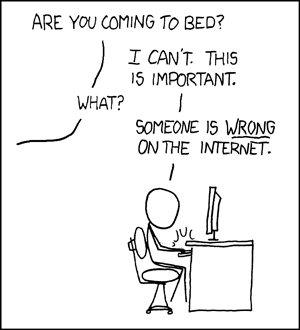Mar 07
Priming Social Software Adoption
From Michael Idinopulos this very nifty little acronym/summary of how to get going with wikis (the principle should work with any social software implementation in my view):
Structure the wiki up-front with stubs and links
Populate it with real content
Review what you’ve done within your core group and refine the structure as needed
Invite a few people who have relevant knowledge and relationships and will be into the idea
Garden the wiki content as things get going.
That makes SPRIG!
At its heart, it’s pretty close to what you might do in establishing a community: find a topic or problem as an attractor, pull people together, get some structure around the focus area, and then get stuck in. I’ve written about wiki raids, and other folks talk about barn-raisings (which makes the community connection much more clearly).
What all this has in common is the willingness just to get stuck in. I saw the importance of this recently at a technology company’s event for their sales partners. The company has a support wiki set up with all sorts of technical information, guidelines, suggestions etc, but it’s being used very passively by only a few sales partners. Meanwhile they are complaining about how long it takes to get an answer to a question, to which the reply was, “but it’s on the wiki!”. I suggested they do a barn-raising then and there to (a) learn how the wiki works, and (b) get used to the idea of sharing their knowledge about the product and the sales process by contributing stuff that everyone could share.
There were two distinct types of people in the room: the ones who wanted to keep talking about the issues, and the ones who just wanted to give it a go then and there. Fortunately the latter half won, and a barn raising was duly held. Sometimes we need to stop talking and just do something.

Mar 04
Faith
I’m at Singapore’s Changi Airport, waiting for my flight to Hong Kong. It’s my first time in the new Terminal 3, built at a cost of more than US$1 billion. As you can see, it’s pretty big, and it’s pretty quiet. It’s designed to add a capacity of 22 million passengers per year to Changi Airport, and you might expect that this won’t happen quickly.
So an investment like this is pretty much a huge act of faith. Which is not to say there’s not also a lot of determination behind it to meet the targets, accompanied by many different interventions, plans and initiatives that go far beyond the owner-manager of the airport, CAAS. It’s part of a national endeavour to maintain Singapore Inc’s competitive edge. And it is one of the more visible emblems of how serious Singapore is about what they want to achieve.
Now why can’t knowledge management initiatives be treated like that? Too often we build the spanking new terminal, but neglect the feeding programmes that will populate it. And by that I don’t mean providing incentives for people to come and walk around it. I mean paying passengers and planes.

Feb 27
On Taking a Fresh Look

Here I am sitting at the international departure gate at Koh Samui airport. You might think from the photo that it was a lobby of a resort hotel. In fact, the whole airport has adopted the architectural metaphor of a resort. It’s a sprawling series of pavilions on one level, all rattan, pitched wooden roofs and open to the air, with lots of breezes floating through. It’s light, airy and welcoming. You can imagine how disconcerting it is to be standing in a line for immigration with orchids and koi ponds around you and not a solid wall in sight. It just goes to show how liberating it can be to deliberately drop a prevailing metaphor. Why should airports look like airports?
Feb 22
With Fond Memories (Not As Mushy As It Sounds)

Today is my last day at Straits Knowledge and as with Patrick, I leave with mixed feelings, though I am not a Piscean. I have been treated with respect and fondness here at Straits, and treated to some very awesome minds and good humour. On reflection, I realized that what mattered most to me was I could see the purpose of what we were doing and how we did it. Our hearts were in the right place all the time… not sure if we could say the same about our heads? ![]()
Feb 21
Frankly…
From Grandad. This doesn’t happen if you’re a Mac user by the way.

Feb 20
Safe-Fail with Enterprise 2.0
Matt has a really nice post about what to do when your early social software experiments get into trouble..
“You want a little structure (policies, templates, limited usage) to begin with. Kinda like the stablisers (AKA training wheels)on this kid’s bike. And then at some point you might want to take the structures away (or at least reduce them), because they are actually slowing you down. Now the first thing that happens when you take the stabilisers away is that the kid falls off the bike. And when this happens we learn our lesson and put an even bigger set of stabilisers on the bike and NEVER TAKE THEM OFF AGAIN. Don’t we?”
Read the whole post.
Feb 20
Message to Self: Must Learn to Let Things Go
From the insanely sane Randall Munroe... especially for those actKM moments when someone is being ridiculous.

Feb 20
Why Bankers Are Like Street Gangs
From John Kay in the Financial Times (thanks to Liam Brown):
“Gangs differentiate themselves by their characteristic beliefs and values. Your performance as a gang member is judged not by rational, objective criteria but by the approbation of your peers. As on the streets, also in the office towers. The people on the floor above fix your bonus and advance your career.
Some beliefs and value systems are more successful than others. The effortless superiority prized at Goldman Sachs seems to have served it well in the subprime crisis. The extreme aggression of Bankers Trust and Credit Suisse First Boston in the 1990s led ultimately to the destruction of these organisations as independent businesses. But always, the beliefs and values that matter are local, not global; subjective, not objective; and to question the prevailing culture is to exclude yourself from the group.”
Now my question is.. can KM benefit from gang-like behaviours too? Or must we remain their victims?
Feb 18
Touch

Knowledge management is far too abstract. Not only does it neglect the concrete, natural ways we use information and knowledge, it over-simplifies the infinitely subtle and sophisticated ways we play with information and knowledge in natural settings. So we make our crude distinctions between tacit and explicit knowledge, or between data, information and knowledge.
And we treat everything as if it’s something that happens in the head, or between heads and heads (involving soundwaves) or heads and text in various forms. Specifically, I don’t see us anywhere talking about the importance of touch. This is not unique to knowledge management – it’s true of management science in general. “Touch” is as crudely understood as knowledge is, notwithstanding the equally subtle and sophisticated ways that we use touch socially. In fact, it’s largely avoided; the role of a bureaucratic organization is to inhibit touch as far as it is possible to do so while still working with humans.
We are, for example, much more comfortable thinking and talking about touching things (to control them), than we are about touching people. Touch screens, touch pads, excite our enthusiasm. Talking about touching our colleagues is deemed improper, inappropriate even.
Feb 15
You Are Deletable
From Danah Boyd this cautionary tale of a fellow who hosted his entire life on Google, fell victim to a phishing scam, his account was misused, and four years of his life were summarily deleted. This reminded me of the actKM deletion event when it was hosted by Yahoo Groups (one member complained to Yahoo! that another member was violating his IP, and the legal boyos decided to keep life simple and removed 7 years worth of messages and 1500 email contacts without notice).
Lesson for me: own your content, and if you’re using a hosted (especially free) service, back everything up. Eg we love Google Calendar, but have an every-15 minute backup onto iCal.

